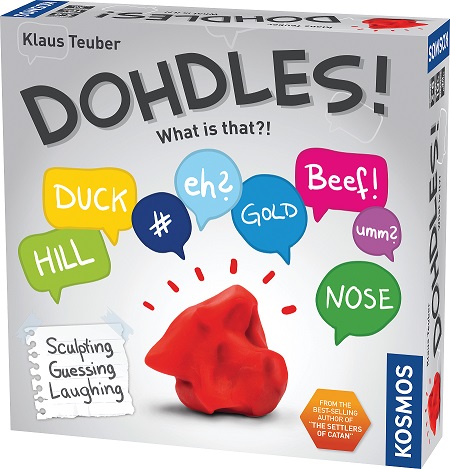I have never been what one might call “artistic.” In the 3rd grade, when we had to make an animal out of clay, I made an alligator that looked more like some sort of spiky worm. My best drawings all involve men and women made of very intricately detailed lines known as “stick figures.” Needless to say, when I had the opportunity to play Dohdles!, a game that revolves around making small figures out of modeling clay, at this year’s GenCon, I approached the game with what can best be described as trepidation. Any worries I might have had quickly disappeared as soon as I took a look at the rules.

In Dohdles! each player is given a lump of colored modeling clay, a question mark player token and, depending on how many people are playing, 2-3 progress markers. Players each make small sculptures and then place them on the board. Once all of the players have finished their sculptures, the players take turns asking yes/no questions or asking for one of the letters in the sculpture’s name. As players guess what each sculpture is, player tokens move forward or backward based on where they are on the board. First player to the smiley face wins. 
Seems fairly simple right? It would be, if it weren’t for some fantastic mechanics that punish players for making sculptures that are too detailed and reward the more vague (read: the only type of sculpting I do) sculpting. Around each sculpture are a series of circles that indicate whether players wanting to know more about a particular sculpture should ask a yes/no question or ask for a letter in the sculpture’s name. Next to each of these circles there is a number starting with zero then going up to three and back down to zero. These numbers are how many points the sculptor gets when another player correctly guesses what she’s sculpted. What this means is that if a player makes the most amazing clay version of say an octopus and someone guesses correctly that it is an octopus before the first question you get no points; however, if you (like me) make something that kind of resembles an octopus and it takes the other players three guesses to figure it out you get three points. On the other hand if you think you’ve made an octopus but in reality you’ve just placed a sphere of clay on the board and it takes 8 or more guesses you get no points. This mechanic is incredibly effective at leveling the playing field. It also injects strategy: players have to decide just how detailed to make their sculptures. The insertion of strategy makes sense when considering that the author of the game is Klaus Teuber who also designed Settlers of Catan.
I really enjoyed Dohdles! and it was one of the most fun games that I got to play at GenCon this year, but it’s not without its issues. Included in the game are suggestion boards that each offer different suggestions as to what a player should sculpt as well as sample questions to ask. These are nice if everyone agrees to use the suggestions included on the boards themselves, but players can go off book and create anything they can imagine. In the 3 times I played this game at GenCon, anytime anyone went off book they would end up getting no points because no one had any idea what they had sculpted. A second smaller problem I found with the games is that it is surprisingly hard to get to the smiley faced finish line. It is so hard in fact that no player in any of the three games that I played made it to the finish line. There are, of course, alternate win conditions, but we all agreed that there is a certain satisfaction in getting to the finish line that you just don’t get from being the closest to the finish line. It’s a small thing, and I’m sure that there are games where players reach the end, but I think the game might would be served well by shortening the the path to the finish line. Even with these flaws I still had a blast playing Dohdles! and would definitely recommend it. It’s light, fun entertainment, and that’s exactly what I look for in a party game.
